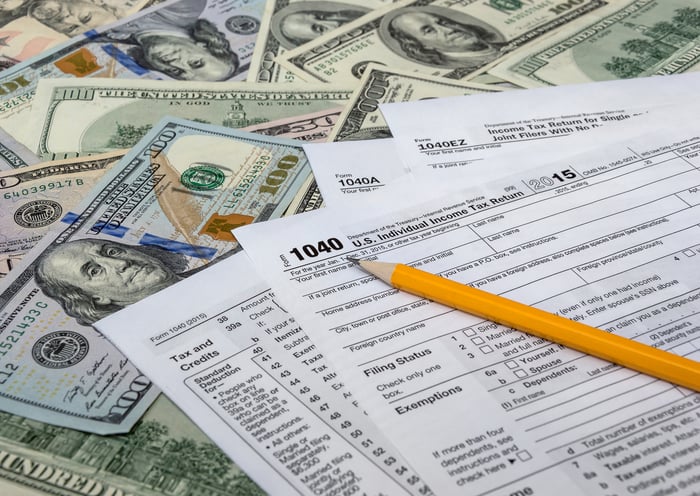The Tax Break the IRS Is Begging You to Take
Millions of taxpayers are eligible but choose not to claim the thousands of dollars this tax credit offers.
by Dan Caplinger (TMFGalagan)Most Americans' goal during tax season is to pay as little tax as possible, and ideally to get a refund that's as large as you can get. Unfortunately, preparing taxes is complicated, and the complex laws governing taxation are so challenging to navigate that many taxpayers end up not claiming tax breaks that could put thousands of extra dollars in their pockets.
It might come as a surprise to learn that the IRS actually wants to encourage taxpayers to take tax breaks, but that's exactly what it's doing on Jan. 31. With the 14th installment of its annual EITC Awareness Day, the tax agency wants to make sure everyone knows about the benefits of claiming the earned income tax credit -- a tax break that it believes 6 million eligible taxpayers leave untouched.

How does the earned income tax credit work?
The earned income tax credit helps workers with modest income levels save on their taxes. For the 2019 tax year, credit amounts can be up to $6,559 for taxpayer families with three or more children, and smaller limits of $5,828, $3,526, and $529 apply to those with families of two, one, or no children, respectively. Below, you'll see the income limits that apply to the credit for 2019, putting an upper bound on how much money you can make and still receive a portion of the credit amount.
| Filing Status | Income Limit if No Children | Income Limit if 1 Child | Income Limit if 2 Children | Income Limit if 3+ Children |
|---|---|---|---|---|
| Single, head of household, or widowed | $15,570 | $41,094 | $46,703 | $50,162 |
| Married filing jointly | $21,370 | $46,884 | $52,493 | $55,952 |
Data source: IRS.
Best of all, the earned income credit is a refundable credit. That means that even if you otherwise wouldn't owe any tax, you can still file a return and get a refund back that includes the credit amount. That's a fairly unusual tax break, and it's one that can sometimes justify filing a tax return even if you wouldn't ordinarily be required to do so.
Why is the IRS promoting the earned income tax credit?
The sad thing about the earned income tax credit is that so many people don't choose to claim it. The IRS estimates that 25 million taxpayers received the earned income tax credit last year, with the average amount received coming in just over the $2,500 mark. However, one out of every five eligible taxpayers failed to claim and receive the credit. Doing the math, that leaves roughly 6.25 million taxpayers having missed out.
IRS Commission Chuck Rettig explained the rationale for the IRS outreach effort:
The EITC is a vital tax credit that helps millions of hard-working working families around the nation. It's critical that people review the credit to see if they qualify. Increasing awareness about the EITC is important, and the IRS is proud to support the ongoing efforts by partner groups across the country for sharing this critical information with taxpayers.
In particular, the IRS identified several groups of taxpayers who are most likely to miss out on the credit. They include the following:
- Those without children.
- Those who live in nontraditional families, such as where grandparents are raising grandchildren
- Those who saw their filing status or income change.
- Those with limited English skills.
- Members of the Armed Forces.
- Those who live in rural areas.
- Native Americans.
- People with disabilities or who care for those who are disabled.
Get what's coming to you
If you qualify for the earned income tax credit, make sure that you claim it. There's no reason to pass up hundreds or even thousands of dollars added to your tax refund. The IRS EITC website provides a tool to help you figure out if you qualify and what the amount of your credit would be. With even the IRS wanting you to take advantage of the credit, it's worth the time as you're preparing your 2019 tax returns to check and see if you qualify.